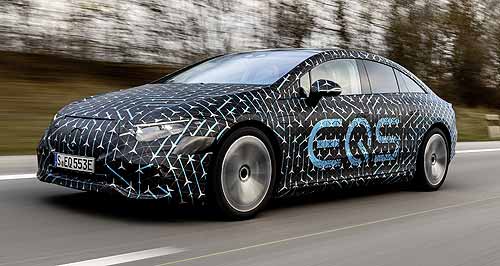Make / Model Search
Future models - Mercedes-Benz - EQSMercedes-Benz EQS EV here early 2022Merc goes first class with electric drive EQS, 770km range and full width glass dash5 Apr 2021 By NEIL DOWLING MERCEDES-BENZ has confirmed its flagship electric vehicle, the EQS, will go on sale in Europe in August and is expected in Australia early in 2022.
The EQS, the equivalent to the S-Class, is shown in camouflage but will be revealed later in the month.
Mercedes-Benz Cars Australia PR and product communications manager Jerry Stamoulis told GoAuto that the EQS will be here in the first quarter of 2022 and that specifications and prices will be released closer to that date.
Pricing is expected to be significantly up on the S Class range that now starts at $240,700 (plus costs) for the S450 and up to $264,900 for the S450L.
The EQS is the first of the EV range from Mercedes to have a unique platform. Current EVs, the EQC and incoming EQA, are based on existing ICE platforms.
The electric vehicle architecture (EVA) will also be used for three all-new EV models – the electric equivalents of the E-Class, GLE and GLS – in the short term and more in the future.
The EQS is also the first to incorporate the MBUX Hyperscreen that combines the instruments, large central screen and a passenger display behind a single piece of glass that runs the full width of the cabin.
Mercedes claims the EQS will be capable of a 770km range – better than any EV on the market – and be more aerodynamic than any previous production car with a drag coefficient of only 0.20.
The S-Class has a coefficient of 0.24 and the current most slippery production car design is shared with two other Mercedes offerings, the A-Class and CLA.
Two EQS versions will be available, the EQS 450 Plus – a single-motor, rear-drive saloon with 245kW/550Nm; and a dual-motor all-wheel drive called the EQS 580 with 385kW/800Nm.
Both will come from launch with a Mercedes-made 108kWh battery pack (26 per cent bigger than the current EQC) but future plans include an optional – and cheaper – EQS with a smaller 90kWh pack.
Recharging times quoted by Mercedes include a charge up to 300km in 15 minutes using a new-gen DC fast charger.
Japanese buyers also have the option of bi-directional charging, feeding it back to the electricity grid when needed.
The company claims electrical consumption of the EQS 450 at 19.1 to 16.0kWh/100km, and the EQS 580 4Matic at 20.0 to 16.9kWh/100km on the NEDC cycle. Both have a top speed limited to 210km/h.
By comparison, Tesla quotes its Model 3 standard at 14.9kWh/100km; the Model S 60 at 18.1kWh/100km; and the Model X Performance at 23.6kWh/100km.
The EQS’s energy recuperation output is a massive 290kW and the company said the car can be braked to a complete stop on the regeneration system alone.
The new-generation lithium-ion battery accents sustainability and has a cobalt portion reduced to just 10 per cent.
The 400-volt battery architecture has very high density for better charging performance and includes a battery management system that can be updated by wireless.
Mercedes will issue EQS owners with a battery performance certificate that promises customers cover for battery loss of capacity that is valid for 10 years or 250,000km.
The rise of the EV is fostered by Mercedes-Benz’s Ambition 2039 mandate that has a goal of a fully networked and carbon-neutral vehicle fleet by 2039.
It pledges that from 2030, it will target more than 50 per cent of passenger car sales with plug-in hybrids or pure electric powertrains, and that production in all its global factories will be carbon-neutral from 2022.  Read more12th of January 2021  Mercedes-Benz debuts MBUX HyperscreenMercedes-Benz’s new MBUX Hyperscreen is a full width, all-digital AI dashAll future models Alfa Romeo Alfa Romeo Abarth Abarth Alpine Alpine Alpina Alpina Audi Audi Aston Martin Aston Martin BMW BMW Bentley Bentley Chery Chery Brabham Brabham Chrysler Chrysler Chevrolet Chevrolet Cupra Cupra Citroen Citroen DS DS Dodge Dodge Fiat Fiat Ferrari Ferrari Foton Foton Ford Ford Great Wall Great Wall FPV FPV Haval Haval GWM GWM Honda Honda Holden Holden Hummer Hummer HSV HSV Infiniti Infiniti Hyundai Hyundai Jaguar Jaguar Isuzu Isuzu Kia Kia Jeep Jeep Land Rover Land Rover Lamborghini Lamborghini Lexus Lexus LDV LDV Mahindra Mahindra Lotus Lotus Mazda Mazda Maserati Maserati Mercedes-AMG Mercedes-AMG McLaren McLaren MG MG Mercedes-Benz Mercedes-Benz Mitsubishi Mitsubishi Mini Mini Opel Opel Nissan Nissan Peugeot Peugeot Pagani Pagani Proton Proton Porsche Porsche Renault Renault Ram Ram Rover Rover Rolls-Royce Rolls-Royce Skoda Skoda Saab Saab SsangYong SsangYong Smart Smart Suzuki Suzuki Subaru Subaru Toyota Toyota Tesla Tesla Volvo VolvoMotor industry news |
Click to shareMercedes-Benz modelsResearch Mercedes-Benz All future models Alfa Romeo Alfa Romeo Abarth Abarth Alpine Alpine Alpina Alpina Audi Audi Aston Martin Aston Martin BMW BMW Bentley Bentley Chery Chery Brabham Brabham Chrysler Chrysler Chevrolet Chevrolet Cupra Cupra Citroen Citroen DS DS Dodge Dodge Fiat Fiat Ferrari Ferrari Foton Foton Ford Ford Great Wall Great Wall FPV FPV Haval Haval GWM GWM Honda Honda Holden Holden Hummer Hummer HSV HSV Infiniti Infiniti Hyundai Hyundai Jaguar Jaguar Isuzu Isuzu Kia Kia Jeep Jeep Land Rover Land Rover Lamborghini Lamborghini Lexus Lexus LDV LDV Mahindra Mahindra Lotus Lotus Mazda Mazda Maserati Maserati Mercedes-AMG Mercedes-AMG McLaren McLaren MG MG Mercedes-Benz Mercedes-Benz Mitsubishi Mitsubishi Mini Mini Opel Opel Nissan Nissan Peugeot Peugeot Pagani Pagani Proton Proton Porsche Porsche Renault Renault Ram Ram Rover Rover Rolls-Royce Rolls-Royce Skoda Skoda Saab Saab SsangYong SsangYong Smart Smart Suzuki Suzuki Subaru Subaru Toyota Toyota Tesla Tesla Volvo VolvoMotor industry news |











Facebook Twitter Instagram